
The Pyraloidea are a moth superfamily containing about 16,000 described species worldwide, and probably at least as many more remain to be described. They are generally fairly small moths, and as such, they have been traditionally associated with the paraphyletic Microlepidoptera.

Thyrocopa is a genus of moths in the family Xyloryctidae endemic to Hawaii. The taxon has approximately forty species, including some flightless species.
Tanaoctena is a genus of moths of the family Galacticidae.

Archyala is a genus of moths belonging to the family Tineidae. This genus is endemic to New Zealand. Archyala was first described by Edward Meyrick in 1889.

Austrocidaria parora is a species of moth of the family Geometridae. It is endemic to New Zealand.

Izatha is a genus of moths of the family Oecophoridae. They are commonly known as lichen tuft moths. This genus is endemic to New Zealand.

Paramorpha marginata is a species of moth in the family Carposinidae. It is endemic to New Zealand and has been observed in the northern parts of the North Island. It has been observed in the canopy of kanuka forest and has been collected and reared from leaf litter beneath Leucopogon fasciculatus. It is regarded as a rarely recorded species.

Circoxena ditrocha is a species of moth in the family Blastodacnidae. This species is endemic to New Zealand and has been collected on both the North and South Islands. The habitat of this species is on the edges of native forest or scrub and it may be associated withPseudopanax arboreus. As at 2000 the host species of this moth is unknown but it has been hypothesised that the larvae are seed borers. Adults are on the wing in December to March. It is classified as "At Risk, Naturally Uncommon" by the Department of Conservation.
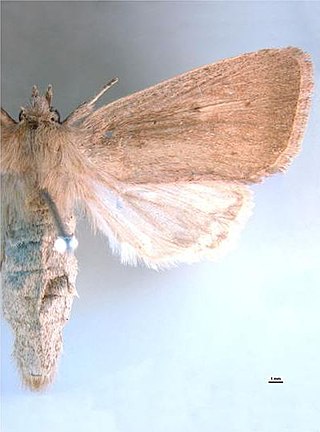
Sesamia grisescens, the pink sugarcane borer, pink stalk borer, shoot borer, sugarcane borer or ramu shoot borer, is a moth of the family Noctuidae. The species was first described by Warren in 1911. It is found in Papua New Guinea, Seram, the Moluccas and New Britain.
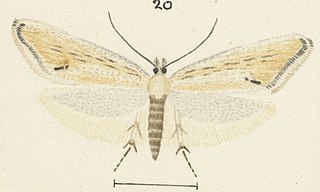
Glyphipterix necopina is a species of sedge moth in the genus Glyphipterix. It is endemic to New Zealand. It is classified as Not Threatened by the Department of Conservation.
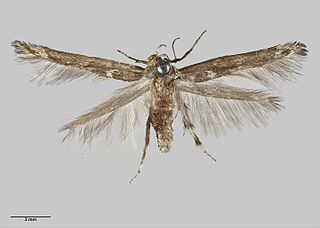
Stathmopoda albimaculata is a species of moth in the Stathmopodidae family. It is endemic to New Zealand and is located in the lower half of the South Island. This species favours habitat that includes the various Olearia species that host its larvae. It has also been found to inhabit lowland podocarp native forest. The larvae feed on species in the genus Olearia. Adults are on the wing between the months of October and February. S. albimaculata is classified as Nationally Endangered by the Department of Conservation.
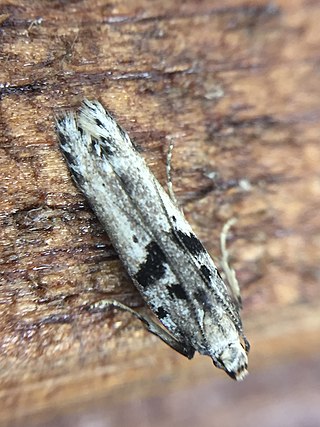
Aristotelia paradesma is a moth of the family Gelechiidae. It was described by Edward Meyrick in 1885 and is endemic to New Zealand. This species has been observed on both the North and South Islands. The larvae feed on Coprosma species creating and living in stem galls. The adults are on the wing from November to March and are attracted to light.

Pseudocoremia fluminea is a species of moth in the family Geometridae. It is endemic to New Zealand. It is classified as Not Threatened by the Department of Conservation.

Adeixis griseata is a species of moth of the family Geometridae. It is endemic to New Zealand and has been collected in the North, South and Chatham Islands. This species inhabits poorly drained or swampy areas. As at 2017 the host plant of this species is unknown however it has been hypothesised that the host plant may be Schoenus brevifolius or another common sedge. Adults have been observed on the wing from October until January.

Archyala culta is a species of moth in the family Tineidae. This species is endemic to New Zealand. It is classified as "Data Deficient" by the Department of Conservation. This species has only been collected at Opoho and is only known from its type specimen.

Zapyrastra stellata is a species of moth of the family Momphidae first described by Alfred Philpott in 1931. It is endemic to New Zealand and has been observed in Otago. The larvae of this species mine the leaves of Meuhlenbeckia. Adults are on the wing in June and December.
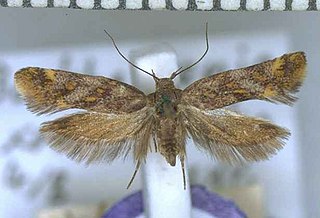
Tingena xanthomicta is a species of moth in the family Oecophoridae. It is endemic to New Zealand and has been found in both the North and South Islands. This species inhabits native scrub on hillsides and appears to be attracted to Coprosma areolata. Adults are on the wing from November until February.

Trachypepla minuta is a moth of the family Oecophoridae first described by Alfred Philpott in 1931. It is endemic to New Zealand and has been collected in Auckland. Adults of this species are on the wing in December. It is distinguishable from similar species as it is smaller in size and darker in appearance than other species in the genus Trachypepla.

Orthenches disparilis is a moth of the family Plutellidae. This species was first described by Alfred Philpott in 1931. It is endemic to New Zealand and has been observed in Auckland and Otago. O. disparilis is associated with species in the genus Corokia and larvae are known to feed on Corokia buddleioides. The larvae mine the leaves and feeds on the shoots and fruit of their host. Adults are on the wing in January. Dracophyllum bushes are used as over wintering sites by the adults.


















